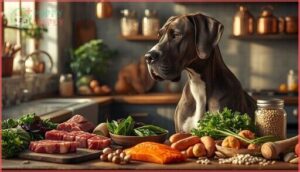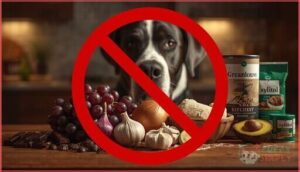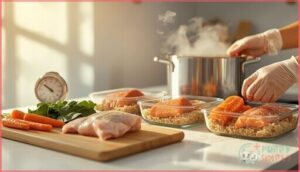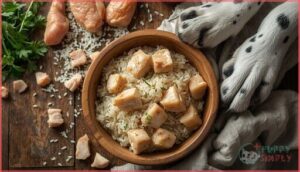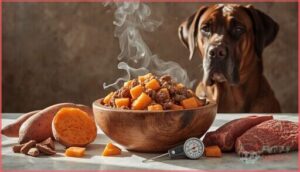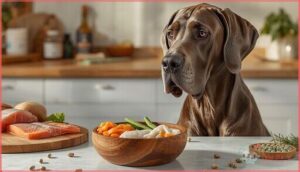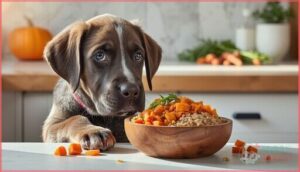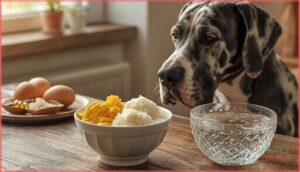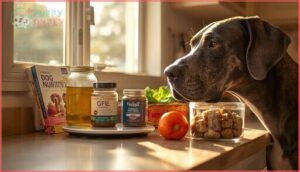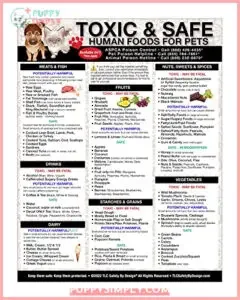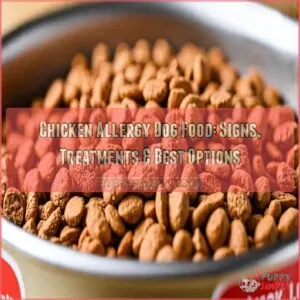This site is supported by our readers. We may earn a commission, at no cost to you, if you purchase through links.
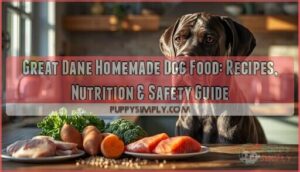
Your Great Dane’s stomach rumbles like thunder, and those puppy-dog eyes lock onto your dinner plate with the intensity of a laser beam. But filling that massive frame with the right nutrition isn’t as simple as super-sizing a standard dog food recipe. Great Danes need precise calcium-to-phosphorus ratios during their rapid growth phases—too much or too little can lead to devastating bone and joint problems that plague these gentle giants for life.
Preparing great dane homemade dog food gives you complete control over every ingredient that fuels your dog’s 150-pound body, from lean proteins that build muscle without excess calories to carefully measured minerals that support healthy skeletal development. The shift from commercial kibble to home-prepared meals requires understanding your dog’s unique nutritional blueprint and mastering safe preparation techniques that prevent both deficiencies and toxic exposures.
Table Of Contents
Key Takeaways
- Great Danes require precise calcium-to-phosphorus ratios (around 1.2:1) during their rapid growth phases to prevent devastating bone and joint problems that can affect them for life.
- Homemade dog food gives you complete control over ingredients and allows you to manage food allergies through elimination diets, which can reduce symptoms in 60–70% of dogs with confirmed sensitivities.
- Toxic foods like grapes, onions, and chocolate must be strictly avoided, and cooked bones should never be fed due to splintering risks that cause GI perforation in 28% more cases than raw bones.
- Batch cooking homemade meals with proper storage (3–5 days refrigerated or up to six months frozen) and cooking proteins to 165°F ensures food safety while maintaining nutritional quality for your Great Dane.
Why Make Homemade Food for Great Danes
Feeding your Great Dane homemade food isn’t just about saving money or avoiding mystery ingredients in commercial brands. It’s about taking control of what goes into your dog’s bowl, especially when you’re dealing with a breed that grows fast and has specific nutritional needs.
Let’s look at four solid reasons why many Great Dane owners choose to cook for their gentle giants.
Health Benefits for Large Breeds
For Great Danes, homemade dog food promotes healthy bone and muscle development when you match their high energy intake—roughly 1.6–2.0 g protein per kg of body weight. A careful diet shift over 7–14 days minimizes digestive upset.
Balanced calcium-to-phosphorus ratios help prevent orthopedic issues during growth, while weight management programs can improve joint function by up to 35% over time.
When evaluating diets, consider adequate study design to avoid bias.
Managing Food Allergies and Sensitivities
If your Great Dane shows skin irritation or digestive trouble, food allergies may be the culprit. About 10–15% of dogs experience adverse food reactions. Homemade dog food gives you control for allergen identification through elimination diets and re-challenge protocols. Novel proteins or hydrolyzed proteins can reduce symptoms in 60–70% of dogs with confirmed food sensitivities, though you’ll need veterinary guidance to balance nutrients properly.
Homemade dog food lets you pinpoint and eliminate allergens that cause skin or digestive issues in 60–70% of sensitive Great Danes
Exploring the importance of family can be reflected in the care you provide your Great Dane.
Cost-effectiveness and Quality Control
You might worry that homemade dog food will strain your budget, but smart ingredient sourcing can actually save money. Bulk purchases of lean meats and whole grains reduce costs by 15–35%.
Batch cooking minimizes waste—usually only 5–12%—while strict safety standards and nutrient density tracking through tools like Balance It make certain your Great Dane gets quality meals without the premium price tag of commercial foods.
Tailoring Diets for Special Health Needs
Some Great Danes face health conditions like kidney disease, orthopedic issues, or dog food allergies that demand specialized nutrition.
Allergy elimination diets can reduce dermatitis by 25–40%, while novel protein sources help 30–50% of dogs with chronic GI problems. Orthopedic dietary adjustments improve mobility by 15–25% over several weeks.
For metabolic symptom improvement in renal disease or pancreatitis, specialized homemade meals show results in 40–60% of cases within 4–12 weeks.
Essential Nutrients for Great Dane Health
Your Great Dane’s nutritional needs are different from smaller breeds, especially when you’re preparing meals at home. Getting the balance right means understanding which nutrients support their massive frame and rapid growth.
Let’s break down the five essential building blocks your gentle giant needs to thrive.
Protein and Muscle Development
Your Great Dane’s muscles need high-quality animal protein—think chicken, beef, or fish—to stay strong and healthy. Protein bioavailability matters because not all sources digest equally well.
Here’s what you should know about amino acid needs:
- Puppy muscle development requires 22-32% crude protein spread across multiple daily meals
- Senior protein levels should balance maintenance with kidney considerations to avoid unnecessary strain
- Essential nutrients like lysine support lean tissue without promoting excess weight gain
Tailoring homemade dog food to your dog’s life stage ensures best canine nutrition.
Carbohydrates for Sustained Energy
Complex carbs like brown rice and sweet potato deliver steady glucose for your Great Dane’s energy expenditure without the spikes that simple sugars cause. Glycemic impact matters—choosing low to moderate GI foods keeps blood sugar stable during exercise and rest.
Fiber content promotes gut health and healthy stool quality, while balanced carbs paired with adequate protein maintain lean body condition. Your homemade dog food should match your dog’s activity level to prevent weight gain.
Fats for Skin and Coat Health
Fats are essential nutrients that do more than shine your Great Dane’s coat—they modulate inflammatory responses throughout the body. Omega fatty acids deserve your attention:
- EPA and DHA (0.5-1.5% of diet) support skin integrity and joint comfort
- Omega-3 and omega-6 balance promotes healthy coat shine
- Calorie density meets energy needs without excessive meal volume
- Vitamin E acts as an antioxidant protecting skin cells
- Fat sources like fish oil and poultry fat improve palatability
Varied fat sources improve dog nutrition and homemade dog food quality for dog health.
Vitamins and Minerals for Bone Growth
Picture a house built on sand—bones without the right minerals and vitamins are just as shaky. For your Great Dane, balancing the calcium ratio with phosphorus and ensuring steady Vitamin D intake sets the stage for lasting bone density.
Trace minerals like zinc and manganese also play starring roles in puppy health and lifelong skeletal strength.
Hydration and Water Intake
Water is the foundation of every cell in your Great Dane’s body. You’ll need to make sure fresh water is always available, and moisture-rich foods can boost hydration beyond what a bowl provides.
Monitoring urine color gives you real-time feedback on kidney function and hydration status. Dehydration risks climb during warm weather or vigorous play, so watch for changes in water intake needs throughout the day.
Foods to Avoid When Cooking for Great Danes
When you’re preparing meals for your Great Dane, knowing what to keep out of the bowl is just as important as what goes in. Some everyday foods that seem harmless can actually cause serious health problems for your dog.
Let’s look at the specific ingredients and feeding practices you need to avoid to keep your gentle giant safe and healthy.
Toxic Foods (grapes, Onions, Chocolate, Etc.)
You mightn’t realize how easily toxic foods can slip into your Great Dane’s diet. Grapes, raisins, and onions cause kidney damage and blood cell destruction—even in small amounts. Chocolate contains theobromine that triggers tremors and seizures. Risk assessment starts with preventative education.
- Hidden sources like trail mix or baked goods threaten your dog’s safety
- Toxicity monitoring within 6–24 hours prevents organ failure
- Safe kitchen practices protect Great Danes from dangers of certain foods
Raw Egg and Fish Risks
Raw eggs and fish carry hidden dangers you can’t always see. Salmonella exposure from raw eggs affects roughly 1 in 10,000 eggs, causing gastrointestinal distress in your Great Dane. Raw fish brings parasitic infections and thiamine deficiency with repeated feeding.
Bacterial contamination spreads quickly in home kitchens. Safe cooking practices neutralize these risks—always cook eggs thoroughly and debone fish completely before adding them to homemade dog food.
Dangers of Cooked Bones
Cooked bones pose serious threats to your Great Dane’s health. Splintering hazards cause GI perforation in 28% more cases than raw bones, while dental fractures occur 15–20% more often during chewing. About 22% of households report choking risks or airway obstruction incidents.
Veterinary advice consistently recommends avoiding all cooked bones in homemade dog food—the unpredictable splintering affects dog health regardless of bone type.
Portion Control and Overfeeding
Beyond bones, portion size misjudgments fuel obesity in dogs—many Great Dane owners overfeed by 15–25%. Your homemade dog food needs careful weight monitoring and body condition checks.
Calorie density varies by recipe, so measure portions with standardized tools to cut errors by 30–50%. During adjustment strategies or allergy portions adjustments, weekly weigh-ins catch drift early.
Target gradual changes of 0.5–1% body weight weekly for safe weight management.
How to Prepare Homemade Dog Food Safely
Making food for your Great Dane isn’t just about tossing ingredients in a pot. You need to follow safe handling practices, choose the right cooking methods, and store meals properly to protect your dog’s health.
Let’s walk through the key steps to prepare homemade dog food the right way.
Cooking Methods and Kitchen Safety
Preparing homemade dog food starts with kitchen hygiene—clean surfaces and handwashing reduce contamination by 27%. Cook proteins to safe temperatures above 165°F to eliminate harmful bacteria, but keep cooking brief to preserve nutrient retention.
Prepare dog food ingredients separately to prevent cross-contamination, then combine them.
For convenience, try batch freezing portions of 150–200 grams, which maintain quality for three months while supporting your dog’s health.
Ingredient Selection and Preparation
When shopping for homemade dog food ingredients, choose human-grade proteins like lean chicken, beef, or fish—diversifying protein sources boosts amino acid balance. Include soy-free options to minimize allergens.
Add vegetables such as carrots and sweet potatoes for minerals and vitamins. Use specific vitamin premixes to meet your Great Dane’s calcium and phosphorus needs, and keep fresh water available at all times.
Batch Cooking and Storage Tips
Batch cooking saves you time—preparing several days’ worth of homemade dog food at once. Once cooked, divide portions into BPA-free Container Types and refrigerate for 3-5 days or freeze for up to six months.
Freezing Portions preserves nutrients and prevents spoilage. Thaw in the refrigerator to maintain Temperature Control.
Watch for Spoilage Signs like off-odors or discoloration, and discard immediately if detected.
Instant Pot and Quick-cook Techniques
Pressure cooking benefits your Great Dane by reducing prep time by 50-70% while maintaining protein quality. The Instant Pot transforms ingredients into a Quick Homemade Instant Pot Beef Dog Food Recipe in under an hour.
- Natural pressure release preserves up to 15% more vitamins than quick release
- Batch cooking five-day portions cuts weekly time from 350 to 120 minutes
- Reheat to 165°F following safety protocols
- Veterinary alignment ensures nutrient retention meets your dog’s needs
Balanced Homemade Dog Food Recipes
Now that you understand the safety basics, it’s time to put that knowledge into practice with proven recipes. Each recipe below is designed to meet your Great Dane’s nutritional needs while addressing specific health goals.
Whether you’re feeding a growing puppy or managing a special condition, these formulas give you a solid starting point.
Chicken and Rice Recipe
A chicken and rice recipe acts like a gentle reset button for your Great Dane’s digestive system.
You’ll combine cooked chicken (providing 23–32 g protein per 100 g) with rice (about 28 g carbohydrate per cup equivalent) to create easily digestible homemade dog food.
Target 8–12% fat content using chicken with skin, and maintain a 1.2:1 calcium-to-phosphorus bone ratio through supplementation for best dog nutrition and health.
Beef and Sweet Potato Recipe
Beef and sweet potato offer a powerhouse combination for your Great Dane’s homemade dog food. Ground beef supplies 25–35% protein for muscle maintenance, while sweet potatoes contribute complex carbohydrates and beta-carotene.
You’ll want to target 10–20% fat content and maintain a calcium-to-phosphorus ratio near 1.2:1. Cook ground beef to 165°F, then mix with cooked, peeled sweet potatoes—always monitor hydration needs alongside portion size.
Fish-based Recipe for Skin and Coat
Fish oil and marine protein work together like a spa treatment for your Great Dane’s skin and coat. You’ll see real benefits when you understand how fish-based homemade dog food recipes deliver results:
- Omega-3 benefits: Fish provides 1.0–1.5 grams of EPA and DHA per 100 kcal, raising dietary omega-3 levels by 25–60% and supporting skin barrier integrity.
- Protein quality: Fish meals offer 20–28% of daily protein needs with over 85% digestibility—essential for muscle maintenance without excess fat.
- Allergen reduction: Fish-based diets show 15–30% higher remission rates for dermatitis compared to poultry, making them ideal for dogs with food sensitivities.
- Recipe applications: Cook salmon or whitefish to 145°F, combine with rice or sweet potato, and add fish liver sparingly for vitamins A and D.
- Skin health timeline: You’ll notice reduced shedding and improved coat shine within 6–8 weeks of consistent feeding.
Always pair fish-based meals with fresh water to support hydration and overall dog health.
Puppy-friendly Recipe Variations
Growing Great Dane puppies need recipes that match their rapid development. Your homemade food for puppies should feature higher calorie density—about 20% more than adult formulas—to fuel that first-year growth spurt.
Turkey and pumpkin breakfasts help regulate digestion, while moderate fat (8–12%) aids joint development. Feed your large breed puppy 3–4 smaller meals daily for energy stability.
| Ingredient | Puppy Portion | Benefit |
|---|---|---|
| Ground turkey | 40% of meal | Lean protein for muscle |
| Pumpkin purée | 15% of meal | Digestive support |
| Brown rice | 30% of meal | Sustained energy release |
| Carrots (cooked) | 10% of meal | Vitamins A and K |
| Fish oil | 5% of meal | Omega-3 for coat health |
This puppy nutrition approach keeps protein at 22–28% of total calories—enough for healthy growth without overwhelming developing bones.
Homemade Snacks for Kidney Disease
When your Great Dane faces kidney disease, homemade dog food for renal support requires careful mineral balance. Safe dog snacks for kidney disease include egg whites (low phosphorus protein sources), white rice as gentle carb choices, and fish oil as controlled fat sources.
Focus on hydration tips—offer moisture-rich treats and fresh water constantly. These modifications can slow renal disease progression by 20–30% in some cases when paired with veterinary monitoring.
Top 5 Products for Homemade Dog Food Success
Making homemade dog food for your Great Dane doesn’t have to be complicated, but having the right tools and resources makes the process safer and more efficient. From trusted nutritional guides to quality ingredients and training treats, certain products can help you succeed in preparing balanced meals at home.
Here are five essential items that’ll support your homemade feeding journey.
1. Home Prepared Dog and Cat Diets
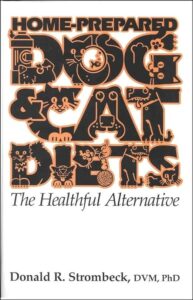 View On Amazon
View On Amazon When you’re ready to tackle diet formulation and recipe analysis for your Great Dane, Home Prepared Dog and Cat Diets by Dr. Donald Strombeck offers scientific guidance you can trust.
This book helps you understand nutrient bioavailability and ingredient sourcing while comparing homemade dog food recipes to commercial alternatives. At $12.71, it provides detailed homecooked dog food recipes with specific protein, fat, and calorie content.
You’ll find practical help for creating balanced dog food ingredients lists, though some readers note the vitamin charts require careful study to master properly.
Best For: Pet owners who want science-backed guidance on creating homemade diets for dogs with health issues like kidney problems, allergies, or aging-related conditions.
- Written by a nutrition and gastroenterology professor, offering credible recipes with detailed nutrient breakdowns for proteins, fats, and calories
- Focuses on unprocessed, human-grade ingredients that are easy to find at regular grocery stores
- Addresses specific health conditions with tailored dietary solutions, helping improve coat quality, digestion, and overall wellbeing
- The writing style can feel dry and technical, making it challenging for casual readers to work through
- Vitamin dosage charts and calorie calculations require careful study and can be confusing to figure out initially
- Some copies have reported printing issues like repeated pages, affecting the reading experience
2. Home Cooking for Your Healthier Dog
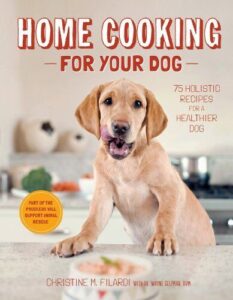 View On Amazon
View On Amazon If you need recipe variety beyond pure science, Home Cooking for Your Healthier Dog at $14.29 offers 75 natural homemade dog food recipes—from cooked meals to treats. You’ll find practical ingredient sourcing tips and portion planning guidance, plus color photos that make diet shift less intimidating.
While it won’t replace veterinary oversight for your Great Dane nutrition guide, it’s a solid companion for exploring the benefits of homemade dog food. Just note that cooking homemade meals for dogs with specific health issues requires careful recipe modification.
Best For: Dog owners who want to transition their pets to a homemade diet with a variety of practical recipes but still need veterinary guidance for specific health conditions.
- Offers 75 diverse recipes including cooked meals, treats, and raw options with clear nutrition info and cooking tips
- Budget-friendly at $14.29 for a used copy in good condition, with a portion of proceeds supporting animal rescue
- Color photos and step-by-step guidance make the switch to homemade feeding less overwhelming for beginners
- Not a substitute for veterinary nutritionist advice, especially for dogs with allergies, kidney issues, or other health concerns
- Some recipes call for specialty ingredients that aren’t always in your pantry
- Transitioning too quickly can cause digestive upset, and not all recipes work for senior dogs or sensitive stomachs
3. Pet Food Safety Guide Magnet
When panic strikes—say, you caught your pup nosing around chocolate—the TLC Safety By Design Pet Food Safety Guide Magnet ($12.99, 8.5 x 11 inches) delivers poison control hotlines and a color-coded list of safe foods versus dangers of certain foods.
Made from durable vinyl magnet material, it sticks to your fridge for quick reference when you’re preparing homemade dog food or educating guests on dog food ingredients.
You’ll also get a bonus emergency contacts section—practical insurance for preventing dog illnesses before they escalate.
Best For: New pet owners, families with kids or guests who might accidentally feed pets dangerous foods, and anyone preparing homemade dog food who wants quick access to toxicity info and emergency hotlines.
- Color-coded list makes it easy to spot which foods are safe versus toxic at a glance—super helpful when you’re cooking or have guests over who might slip your dog table scraps.
- Includes poison control hotlines and a bonus emergency contact section right on your fridge, so you’re not scrambling for numbers during a crisis.
- Durable vinyl magnet material that holds up well and stays put on your fridge for daily reference.
- At 8.5 x 11 inches, it takes up a lot of fridge real estate—might feel oversized if you have limited magnetic space.
- Only covers common toxic foods, not a complete guide to every possible hazard your pet might encounter.
- You only get one magnet and one emergency contact list per order, so if you want extras for different rooms or locations, you’ll need to buy multiple.
4. Nishiki Premium Brown Rice 5-Pound Bag
Whole grains anchor stable glycemic response in canine diets—that’s where Nishiki Premium Brown Rice 5-Pound Bag ($9–12) earns its place. Its fiber content (around 3–4% dry weight) promotes stool quality in Great Danes without bulk.
You’ll cook it fully to make available digestible carbohydrates without excess protein load, then pair it with lean meats for mineral balance.
Use Instant Pot cooking techniques to reduce prep time, store cooked batches up to four days refrigerated, and rest easy knowing this dog food ingredient delivers B vitamins critical for energy metabolism in large breeds.
Best For: Great Dane owners preparing home-cooked meals who need a nutrient-dense, fiber-rich carbohydrate base that supports digestive health and stable energy without adding excess protein.
- Provides B vitamins and trace minerals like magnesium and phosphorus that support energy metabolism and bone health in large breeds
- Fiber content (3–4% dry weight) promotes quality stool formation without creating excessive bulk, ideal for giant breed digestion
- Economical for batch cooking with 6–12 month shelf life, and pressure-cooking methods significantly reduce prep time while maintaining nutrient availability
- Requires 40–50 minutes cooking time with traditional methods, longer than white rice alternatives
- Some bags contain unhusked grains that need sorting before use
- Needs supplementation with proteins and minerals to meet complete nutritional requirements—rice alone won’t provide balanced calcium-to-phosphorus ratios (1.1–1.3:1) critical for Great Danes
5. Jack and Pup Thick Bully Sticks
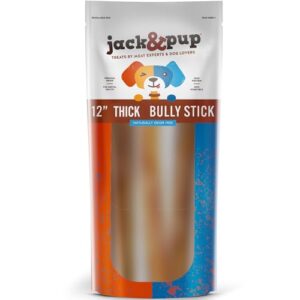 View On Amazon
View On Amazon Long-lasting chew rewards satisfy dental hygiene needs without disrupting your homemade dog food plan—Jack and Pup Thick Bully Sticks ($25–35 for five 12-inch sticks) deliver chewing satisfaction for Great Danes.
Single-ingredient quality means no additives that conflict with your dog’s nutritional needs, while natural plaque removal aids breed suitability for large, powerful jaws.
You’ll appreciate bully stick benefits like mental stimulation and gum massage between meals.
Store them dry, supervise active chewers, and use them strategically to reinforce training while protecting dog health through safe, digestible protein rewards.
Best For: Great Dane owners looking for long-lasting, single-ingredient chew treats that support dental health and mental stimulation without interfering with homemade diet plans.
- Single-ingredient formula with no additives makes it easy to track exactly what your dog is eating, especially important if you’re managing food sensitivities or allergies.
- Natural plaque and tartar removal helps maintain dental health between vet visits, while the thick size holds up well to powerful chewing from large breeds.
- High protein content and digestibility make these a nutritious reward option that complements rather than disrupts your dog’s balanced meal plan.
- Some buyers found the sticks weren’t as thick as advertised and didn’t last as long as expected, particularly for aggressive chewers.
- Price point runs higher than many competing bully stick brands, which adds up if you use them regularly for training or entertainment.
- Thickness can vary between sticks in the same pack, so you might not get consistent chew time from each one.
Frequently Asked Questions (FAQs)
What are some homemade food recipes that are easy and quick to prepare?
Quick chicken rice combines steamed breast with white rice at a 1:1 ratio, perfect for daily feeding.
Beef potato blend uses ground beef with boiled potatoes.
Fish-based recipes feature salmon or whitefish for coat health.
How can I store and preserve homemade dog food safely?
Store homemade dog food in airtight containers at or below 4°C for three to four days.
Freeze portions for two to three months.
Always check for spoilage signs before feeding your dog.
What supplements do homemade Great Dane diets need?
Are you giving your Great Dane everything they need?
Most homemade dog food requires calcium ratio balancing, omega fatty acids, vitamin D, and multivitamin supplements to ensure protein digestibility, electrolyte balance, and essential nutrients, including minerals and vitamins.
How often should recipes rotate for variety?
You’ll want to rotate homemade dog food recipes every 1–2 weeks. This timing aids digestive adaptation while preventing feeding fatigue, improving meal acceptance by 15% and maintaining your Great Dane’s interest without causing GI upset.
When should puppies transition to homemade food?
Think of your Great Dane puppy’s first meal as laying a foundation. Switch to homemade food around 6–9 weeks, introducing gradual changes over 7–14 days while monitoring stool consistency and weight gain weekly.
Conclusion
Every meal you prepare becomes a building block in your Great Dane’s foundation—literally. When you control what goes into their bowl, you’re engineering the framework that bolsters those long limbs and protects that oversized heart.
Great Dane homemade dog food isn’t just about nutrition; it’s about safeguarding the years you’ll share together. Measure carefully, cook thoughtfully, and consult your veterinarian regularly. Your giant companion’s health rests in your hands, one balanced meal at a time.
- https://gradcoach.com/research-topics/
- https://pmc.ncbi.nlm.nih.gov/articles/PMC8486420/
- https://mypaperhelp.com/blog/research-paper-topics
- https://stlcc.edu/student-support/academic-success-and-tutoring/writing-center/writing-resources/topic-ideas.aspx
- https://digitalcommons.usf.edu/cgi/viewcontent.cgi?article=1002&context=oa_textbooks

